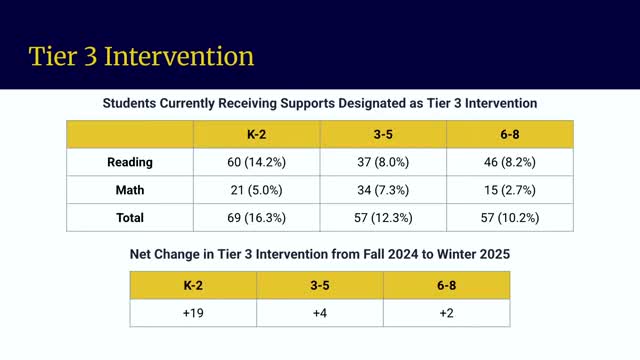School District adds interventionists to enhance tier 3 support for struggling students
May 20, 2025 | Whitnall School District, School Districts, Wisconsin
This article was created by AI summarizing key points discussed. AI makes mistakes, so for full details and context, please refer to the video of the full meeting. Please report any errors so we can fix them. Report an error »

In a recent school board meeting held in Wisconsin, educators shared important updates regarding student support systems, particularly focusing on tier 3 interventions. As the meeting unfolded, the atmosphere buzzed with a sense of urgency and commitment to student success.
The discussion highlighted the structured approach taken by the district to identify students in need of additional support. Each fall, educators convene to analyze screening data, determining which students would benefit from immediate intervention. This process is revisited in winter, allowing for adjustments based on the latest screening results. Notably, this winter marked the introduction of AIMSweb Plus screening for kindergarten through third grade, a significant step in tailoring support to individual student needs.
A key development mentioned was the addition of new interventionists at Hills Corners and the middle school. Previously, these positions were shared, but the change has allowed for more dedicated hours to assist students requiring tier 3 interventions. This strategic move contributed to an increase in the number of students receiving targeted support, particularly in the early grades. From fall to winter, the district saw an addition of 19 students in tier 3 interventions for kindergarten through second grade, while third through fifth grades added four, and sixth through eighth grades saw an increase of two.
Despite these increases, the district aims to keep the percentage of students receiving tier 3 interventions between 5 to 10 percent. Currently, the numbers for K through 2 reading are slightly above this target, attributed to the personalized reading plans developed for students. However, for other grade bands, the percentage remains below the 10 percent threshold.
As the meeting concluded, the board members and educators reflected on the importance of these interventions, recognizing that some students require both reading and math support. This comprehensive approach underscores the district's commitment to ensuring that every student has the opportunity to thrive academically, paving the way for future discussions on educational strategies and resource allocation.
The discussion highlighted the structured approach taken by the district to identify students in need of additional support. Each fall, educators convene to analyze screening data, determining which students would benefit from immediate intervention. This process is revisited in winter, allowing for adjustments based on the latest screening results. Notably, this winter marked the introduction of AIMSweb Plus screening for kindergarten through third grade, a significant step in tailoring support to individual student needs.
A key development mentioned was the addition of new interventionists at Hills Corners and the middle school. Previously, these positions were shared, but the change has allowed for more dedicated hours to assist students requiring tier 3 interventions. This strategic move contributed to an increase in the number of students receiving targeted support, particularly in the early grades. From fall to winter, the district saw an addition of 19 students in tier 3 interventions for kindergarten through second grade, while third through fifth grades added four, and sixth through eighth grades saw an increase of two.
Despite these increases, the district aims to keep the percentage of students receiving tier 3 interventions between 5 to 10 percent. Currently, the numbers for K through 2 reading are slightly above this target, attributed to the personalized reading plans developed for students. However, for other grade bands, the percentage remains below the 10 percent threshold.
As the meeting concluded, the board members and educators reflected on the importance of these interventions, recognizing that some students require both reading and math support. This comprehensive approach underscores the district's commitment to ensuring that every student has the opportunity to thrive academically, paving the way for future discussions on educational strategies and resource allocation.
View full meeting
This article is based on a recent meeting—watch the full video and explore the complete transcript for deeper insights into the discussion.
View full meeting
